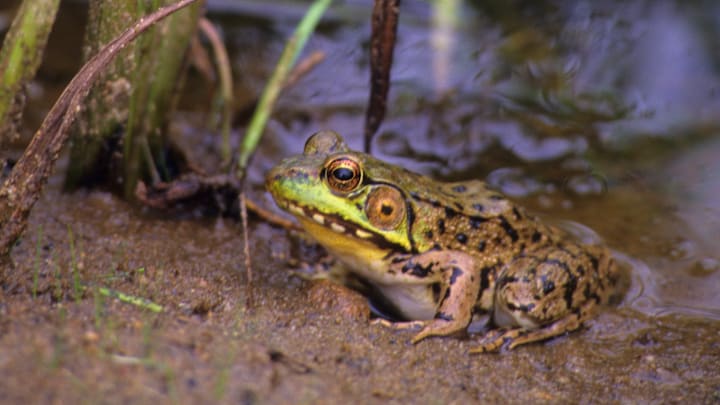Changing sex is not uncommon in the animal kingdom: Thousands of species have evolved this amazing capability. Some are genetically programmed to experience a mid-life switch, while others change from one sex to another due to environmental cues. Let's look at seven animals with fluid physiology.
- Slipper Snails
- Bluehead Wrasses
- Clownfish
- Dwarf Hawkfish
- Green Frogs
- European Pond Turtles
- Spiny Softshell Turtles
Slipper Snails
Native to the U.S. East Coast, slipper snails (a.k.a. slipper limpets) have peculiar home lives. They live in stacks, one on top of the other, like sentient LEGO bricks. Eventually their shells grow around each other and prevent the individuals from moving, creating chains of up to a dozen or more in interesting shapes as their numbers grow.
But there’s a strategy in these stacks. Slipper snails are sequential hermaphrodites; they start life as one sex and permanently change to the other. In their case they begin as males and change into females in a protandrous sequence. (Animals that begin life as female and then change to male are protogynous.)
Young males look for a hard surface to settle down on—often that’s another slipper snail—resulting in a stack where the oldest females will be on the bottom and small males will be on top. Those in the center may be in a transitional stage from male to female. If a male is separated from the stack somehow, he will transition to female on his own. A male mates with the female beneath him, who then releases free-swimming larvae. Research from the Smithsonian Tropical Research Institute has revealed that the touch of another living snail is necessary to trigger an individual’s transition.
Bluehead Wrasses

These colorful Caribbean wrasses are one of about 500 fish species that can change sex. They all start out as females but the largest individuals will transition into males, turning their trademark blue when they complete the 20-day process. These newly minted males keep a harem of females with whom they spawn one at a time.
In a 2019 study, scientists from New Zealand’s University of Otago triggered sex changes among female bluehead wrasses by removing some males from a group living near Key Largo, Florida. The females’ genes stopped producing sex-specific hormones and, within 10 days, their ovaries morphed into testes. The former females can actually become fish fathers.
Clownfish
For these charismatic fish native to the Indo-Pacific, size really matters. In fact, it largely determines their fate.
Like slipper snails, clownfish are sequential hermaphrodites who begin life as male and transition to female. They live in groups of many small males with one large male and female who constitute the breeding pair. If the large female dies, her partner changes into a female and takes her place. Then the largest of the smaller males grows bigger quickly and becomes her mate. When the female lays about 1000 eggs at the next full moon, the male will fertilize and guard them until they hatch.
Dwarf Hawkfish

These Indo-Pacific fish are not quite 3 inches long. They live in harems in which a female can change her sex and mate as a male if necessary. If, for example, there are too many females in a community, the largest female can become a male to keep a better balance.
The hawkfish have another trick up their fins: They can change back to their original sex if the situation calls for it. Should a new male be challenged by a larger male for control of the harem, and it’s a fight he will likely lose, he can just revert to female and avoid the conflict.
Green Frogs
These amphibians mix up the modes of sex determination. They can be born genetically male or female but are able change sexual characteristics under certain conditions. It was first thought that human-caused pollution (such as estrogen in wastewater) triggered the changes, but a 2019 study showed that even frogs in pristine ponds changed sex at about the same rate as frogs in ponds in a variety of suburban environments. That proportion was generally under 5 percent but, in one pond, it rose to 10 percent. “Our data perhaps begin to suggest that … sex reversal may be a relatively natural process in amphibians,” the study’s authors write.
European Pond Turtles

In many turtle species, the sex of the individuals is determined by temperature. Scientists have figured out that European pond turtle embryos, for example, become male or female at certain temperature thresholds. In lab-based studies, clutches of eggs incubated at 86°F or warmer produced all-female broods, and eggs incubated at 77°F or cooler resulted in all-male broods. Eggs kept at a temperature between 77°F and 86°F resulted in groups of mixed-sex baby turtles.
This phenomenon has become more noticeable in the wild as global warming increases. In 2018, scientists in Australia found that green sea turtle populations on nesting beaches closest to where the Great Barrier Reef showed the most bleaching were nearly all female. The resulting study in the journal Current Biology suggested that higher temperatures related to climate change were skewing the turtles’ sex ratio [PDF].
Spiny Softshell Turtles
Female spiny softshells have a mismatched pair of ZW chromosomes, while males have matched ZZ or single Z chromosomes. In 2021, researchers from Iowa State University found that, in the early stages of embryonic development, female and single-Z male turtles expressed Z proteins at twice the rate of ZZ males—essentially “catching up” with the ZZ individuals so they all appeared to be male. In later stages, Z expression in some turtles dropped to allow the W chromosome to emerge and make the embryo female.
Temperature affected sex determination in spiny softshells as well. In cool incubation temperatures, the decrease in Z expression was more pronounced and encouraged development of females. Even turtles need their Zs.
Read More Fascinating Facts About Animals:
